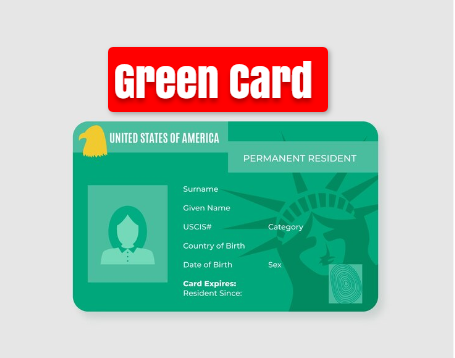Different Types of Green Cards: Which One Is Right for You?

Getting a U.S. green card marks a turning point for anyone seeking to make the United States their permanent home. Officially referred to as the Permanent Resident Card, the green card opens doors to various benefits, including ultimate citizenship, and gives its possessor the freedom to live and work in the United States continually. Nonetheless, the types of green cards differ based on the conditions of the applicant, thus it is important to find the category that fits your case. The different types of green cards, their eligibility requirements, the application process, and key advice to assist you in effectively negotiating the system are explored in this detailed guide.
What Is a Green Card?
Issued by the U.S. government, a green card is an identifying document that provides foreign nationals permanent residency. It proves one’s right to live, work, and travel both inside and outside of the United States. Many questions, given its name, why is it named green? Originally introduced in a greenish color, the name came from that. The nickname green card has stayed connected with the permanent resident card, even if the style and color of the card have varied with time.
What Are the Benefits of a Green Card?
Among the many advantages, a green card provides:
- The freedom to live and work anywhere in the United States without limitations.
- Availability of federal perks, including Social Security.
- Capacity to sponsor relatives for their green cards.
- As a permanent resident, protection under U.S. laws and the opportunity to seek citizenship once residency conditions have been satisfied.
Different Types of Green Cards
The U.S. immigration system provides numerous types of green cards, each suited to particular eligibility requirements. Knowing these green card classifications will enable you to choose the one best for your situation.
-
Family-Based Green Card Applications

Family-based green cards are among the most often used types of green cards in the USA. Under two basic categories—U.S. citizens and permanent residents can sponsor particular relatives for a green card:
o Immediate Relatives of U.S. Citizens: Included among the immediate relatives of U.S. citizens are spouses, unmarried children under 21, and parents of citizens. The fastest approach to getting a green card is this category since it lacks numerical restrictions.
o Family Preference Categories: Included among family preference categories are siblings, married children, and other relatives of U.S. citizens or permanent residents. Longer wait times follow from annual numerical limits used in this category.
Key Requirements for Family-Based Green Cards
- Important criteria for family-based green cards include evidence of a tie to the sponsor—birth certificates, marriage certificates, etc.
- The sponsor has to meet income criteria and complete Form I-130, the Petition for Alien Relative.
-
Employment-Based Green Cards
Another common path divided into five categories depending on priority levels is employment-based green cards:
- EB-1 (Priority Workers): For people with exceptional talent—that of scientists, sportsmen, or CEOs.
- EB-2 (Advanced Degree Holders): For experts in their industry with outstanding skills or advanced degrees.
- EB-3 (Skilled Workers): For positions needing at least two years of training or experience.
- EB-4 (Special Immigrants): For some young people, international organization staff, and religious workers.
- EB-5 (Investors): Generating at least 10 employment for those investing $1 million (or $500,000 in designated locations) in American companies.
Steps for Employment-Based Green Cards
- Get a job offer, then have your company register a labor certification with the Department of Labor.
- Submit the foreign worker immigrant petition, Form I-140.
-
Lottery Green Cards for Diversity Visas, or DV
The Diversity Visa Lottery, sometimes known as the Green Card Lottery, grants 55,000 cards yearly to people from low-immigration nations to the United States.
Eligibility for Diversity Visa Green Cards
- Diversity Visa Green Card eligibility requires one to be from a nation the State Department lists as eligible.
- Either possess two years of qualifying job experience or a high school diploma.
-
Humanitarian-Based Green Cards
Humanitarian green cards are saved for those in extreme need, such as:
o Asylees and Refugees: Following one year of residence in the United States, those awarded asylum or refugee status could seek a green card.
o Victims of Abuse (VAWA): Included are parents of U.S. citizens or permanent residents, children, and battered spouses.
o Victims of Human Trafficking or Crimes (T and U Visas): Human trafficking or crime victims (T and U Visas) let survivors apply for permanent residency following eligibility criteria.
-
Green Cards for Special Immigrants Juvenile (SIJ) Status
Children who cannot return to their own country when their parents abandon, mistreat their children or neglect them could be eligible for SIJ status.
The Green Card Application Process: Step-by-Step Guide
Applying for a green card calls for an understanding of the process of green card applications. The thorough guide is below:
-
Determine Your Eligibility
Determine which type of green card best fits your circumstances—family-based, employment-based, or humanitarian.
-
File the Initial Petition
o Applications from families file Form I-130, the Petition for Alien Relative.
o Applicants based on employment file Form I-140, the immigrant petition for alien workers.
-
Wait for Priority Dates
If your application belongs in a preference category, find current priority dates in the Visa Bulletin. Immediate relations are not required to wait for this phase.
-
Submit Form I-485 or Consular Processing
o If you are in the United States, complete Form I-485 (Application to Adjust Status).
o Complete consular procedures at a U.S. embassy or consulate if you are outside the country.
-
Attend Biometrics Appointment

Background checks will call for your submission of fingerprints, pictures, and a signature.
-
Attend Your Green Card Interview
Most green card candidates have to show up for an interview to confirm the details on their application.
-
Receive Your Green Card
If your application is approved, you will get your Permanent Resident Card, formally conferring upon your permanent residence.
Challenges and Common Issues in the Green Card Process
Although getting a green card marks a turning point in life, candidates sometimes have difficulties, including:
-
Long Waits and Backlogs
Some groups, including family preference and employment-based green cards, have annual number limits, which cause years-long waiting.
o To track your priority date, keep current on the Visa Bulletin. If your waiting period seems abnormally long, get legal help.
-
Inaccurate or Insufficient Applications
o Errors in forms, missing documents, or inaccurate information can cause delays or denials.
o Solution: Review all forms and supporting records twice-fold. Working with an immigration attorney will help you avoid costly mistakes.
-
Difficulties Demonstrating Eligibility
To satisfy the requirements for their particular green card category, applicants must offer enough proof.
o Family-based candidates, for instance, have to show the validity of relationships.
o Employment-based candidates could have to show that suitable American workers are not readily available.
Solution: Before turning in your application, compile thorough, verified records.
-
Medical Ineligibility

Part of the application procedure is a medical check. Ineligibility can arise from some medical disorders like communicable diseases or missing necessary vaccines.
Facilities for Green Card Holders in the USA
You have various advantages as a green card holder:
- Right to work anywhere in the United States.
- Social Security and Medicare eligibility following qualifying requirements.
- Freedom to travel abroad, subject to some constraints.
- Ability to sponsor qualified family members for their green cards.
Tips for a Successful Green Card Application
- Stay organized: Save copies of all of your letters and records.
- Get Professional Advice: Immigration lawyers can guide you through difficult problems.
- Track Visa Bulletins: If under preferred categories, keep track of priority dates.
- Prepare for Your Interview: Answer questions honestly and clearly.
- Submit Accurate Forms: Mistakes could slow down or even stop your application process.
Conclusion
Getting permanent residency in the United States depends critically on choosing the right green card. Whether your application falls under family, work, or humanitarian categories, knowing the green card classifications and the application process will enable you to properly negotiate the path.
Following the green card step-by-step advice shown here will raise your chances of a strong application. Visit Passage Immigration Law to meet seasoned immigration lawyers whether you’re ready to begin your green card application or require professional advice. Let us enable your American dream to come true.
